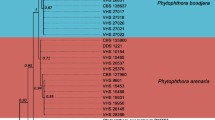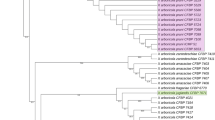Abstract
The glassy-winged sharpshooter (GWSS), Homalodisca coagulata (Say), is an efficient vector of the phytopathogenic bacterium Xyllela fastidiosa. Native to the Southeast US, it was introduced to California, where its presence has caused a sharp increase in X. fastidiosa-based disease. Here are described three fungi associated with GWSS in its native range, including a Hirsutella species that is the predominant mycopathogen detected in sampled GWSS populations. Also described are potentially novel species of Pseudogibellula and Sporothrix. Data garnered from examination of in␣situ and in vitro morphological characters were compared to published keys and type specimen descriptions to achieve morphology-based identification. ITS1-5.8S-ITS2 and partial sequences of the large subunit (LSU)-rDNA, actin, and β-tubulin genes of several GWSS Hirsutella isolates were sequenced and analyzed. Phylogenetic analysis of the LSU-rDNA and tubulin of the GWSS Hirsutella in combination with sequence data generated from other Hirsutella species defined the GWSS isolates to belong to subgroup II within this genus. The combination of phenotypic and genotypic data demonstrated GWSS Hirsutella to be a new species and as such, has been designated Hirsutella homalodiscae nom. prov. Species-specific PCR primers, designed from intron and exon regions of the actin and tubulin genes, were used in a multiplex reaction for the in situ identification of H. homalodiscae. A total of 246 mummified GWSS collected from sites in the southeastern US were subjected to multiplex PCR analysis. More than 70% of these samples tested positive for the presence of H. homalodiscae demonstrating it to be the major mycopathogen distributed throughout the native range of GWSS.
Similar content being viewed by others
References
Alderz W.C. (1980). Ecological observations on two leafhoppers that transmit the Pierce’s disease bacteria. Proc. Florida State Hort. Soc. 93:115–120
Altschul S.F., Madden T.L., Schaffer A.A., Zhang J., Zhang Z., Miller W., Lipman D.J. (1997). Gapped BLAST and PSI-BLAST: a new generation of protein database search programs. Nucleic Acids Res. 25:3389–3402
Andersen P.C., Brodbeck B.V. (1989). Diurnal and temporal variations in the chemical profile of xylem exudate from Vitus rotundifolia. Physiol. Plant 75:63–70
Andersen P.C., Brodbeck B.V., Mizell R.F. III (1989). Metabolism of amino acids, organic acids and sugars extracted from the xylem fluid of four host plants by adult Homalodisca coagulata. Entomol. Exp. Appl. 50:149–159
Bethke J.A., Campbell K.A., Blua M.J., Redak R.A., Yanega D.A. (2001). Range extension of Pseneo punctatus Fox and notes on predation of an introduced sharpshooter, Homalodisca coagulata (Say). Pan-Pacific Entomol. 77:54–56
Brodbeck B.V., Mizell R.F. III, French W.J., Andersen P.C., Aldrich J.H., (1990). Amino acids as determinants of host preference for the xylem feeding leafhopper, Homalodisca coagulata (Homoptera: Cicadellidae). Oecologia 83:338–345
Chandler D., Davidson G., Pell J.K., Ball B.V., Shaw K., Suderland K.D. (2000). Fungal biocontrol of Acari. Biocont. Sci. Technol. 10:357–384
Chen S.Y., Liu X.Z., Chen F.J. (2000). Hirsutella minnesotensis sp. nov. – a new pathogen of the soybean cyst nematode. Mycologia 92:819–824
Curran J., Driver F., Ballard J.W.O., Milner R.J., (1994). Phylogeny of Metarhizium: analysis of ribosomal DNA sequence data. Mycol. Res. 98:547–552
De Hoog G.S. (1974). The genus Blastobotrys, Sporothrix, Calcarisporium and Calcarisporella gen. nov. Stud. Mycol. 7:1–84
Farris J.S., Källersjö M., Kluge A.G., Bult C. (1994). Testing significance of incongruence. Cladistics 10:315–319
Hopkins D.L. (1989). Xylella fastidiosa: a xylem-limited bacterial pathogen of plants. Ann. Rev. Phytopathol. 27:271–290
Hopkins D.L., Purcell A.H. (2002). Xylella fastidiosa: cause of Pierce’s disease of grapevine and other emergent diseases. Plant Dis. 86:1056–1066
Hywel-Jones H.G. (1997). Hirsutella species associated with hoppers (Homoptera) in Thailand. Mycol. Res. 101:1202–1206
Jaffee B.A. (2000). Augmentation of soil with the nematophagous fungi Hirsutella rhossiliensis and Arthrobotrys haptotyla. Phytopathology 90:498–504
Kanga L.H.B., Jones W.A., Humber R.A., Boyd D.W. Jr., (2004). Fungal pathogens of the glassy-winged sharpshooter Homalodisca coagulata (Homoptera: Cicadellidae). Fla. Entomol. 87:225–228
Kiffer E., Morelet M. (2000). The Deuteromycetes : Mitosporic Fungi, Classification and Generic Keys. Science Publishers, Enfeld, NH
Kishino H., Hasegawa M. (1989). Evaluation of the maximum likelihood estimate of the evolutionary tree topologies from DNA sequence data, and the branching order in hominoidea. J. Mol. Evol. 29:170–179
Kurtzman C.P., Robnett C.J. (1997). Identification of clinically important ascomycetous yeasts based on nucleotide divergence in the 5′ end of the large-subunit (26S) ribosomal DNA gene. J. Clin. Microbiol. 35:1216–1223
Lee K.L., Buckley H.R., Campell C.C. (1975). An amino acid liquid synthetic medium for development of mycelial and yeast forms of Candida albicans. Sabouraudia 13:148–153
Lim T.K., Chung G.F. (1995). Occurrence of the entomopathogen, Hirsutella versicolor Petch, on Idioscopus nitidulus Wlk., the mango leafhopper, in Malaysia. Planter 71:207–211
Lipscomb D.L., Farris J.S., Källersjö M., Tehler A. (1998). Support, ribosomal sequences and the phylogeny of the eukaryotes. Cladistics 14:303–338
Lockhart P.J., Steel M.A., Penny D. (1994). Recovering the correct tree under a more realistic model of evolution. Mol. Biol. Evol. 11:605–612
Maddison D.R., Maddison W.P. (2000). MacClade 4: Analysis of Phylogeny and Character Evolution. Sinauer Associates, Sunderland, Mass
Maimala S., Tartar A., Boucias D., Chandrapatya A. (2002). Detection of the toxin hirsutellin A from Hirsutella thompsonii. J. Invertebr. Pathol. 80:112–126
Mains E.B. (1949). New species of Torrubiella, Hirsutella and Gibellula. Mycologia 41:303–310
Mattson W.J. (1980). Herbivory in relation to plant nitrogen content. Ann. Rev. Ecol. Syst. 11:119–161
McCoy C.W. (1981). Pest control by the fungus Hirsutella thompsonii. In: Burges H.D. (eds), Microbial Control of Pest and Plant Diseases, 1970–1980. Academic Press, London, pp. 499–512
McCoy, C.W., 1996. Pathogens of eriophyid mites. In: E.E. Lindquist, M.W. Sabelis and J. Bruin (eds), Eriophyid Mites: Their Biology, Natural Enemies, and Control. Elsevier Science. pp. 481–490
Minter D.W., Brady B.L. (1980). Mononematous species of Hirsutella. Trans. Brit. Mycol. Soc. 74:271–282
Mizell R.F., III, French W.J. (1986). Leafhopper vectors of phony peach disease: feeding site preference and survival on infected and uninfected peach, and Seasonal response to selected host plants. J. Entomol. Sci. 22:11–22
Purcell A.H. (1979). Leafhopper vectors of xylem-borne plant pathogens. In: K. Maramorosch and K.F. Harris (eds), Leafhopper Vectors and Plant Disease Agents. Academic, New York. pp. 603–625
Purcell A.H. (1989). Homopteran transmission of xylem-inhabiting bacteria. In: Harris K.F., (ed), Advances in Disease Vector Research. Springer-Verlag, New York. pp. 243–266
Samson R.A., Evans H.C. (1973). Notes on entomogenous fungi from Ghana. I. The genera Gibellula and Pseudogibellula. Acta Bot. Neerl. 22:522–528
Samson R.A., Evans H.C., Latgé J.P. (1988). Atlas of Entomopathogenic Fungi. Springer Verlag, Berlin
Samson R.A., Van Reenen-Hoekstra E.S., Evans H.C. (1989). New Species of Torrubiella Ascomycotina Clavipitales on insects in Ghana. Stud. Mycol. 31:123–132
Swofford D.L. (2000). PAUP*. Phylogenetic Analysis Using Parsimony (*and Other Methods). Version 4. Sinauer Associates, Sunderland, MA
Tartar A., Boucias D., Adams B., Becnel J. (2002). Phylogenetic analysis identifies the invertebrate pathogen Helicosporidium sp. as a green algae (Chlorophyta). Int. J. System. Evol. Microbiol. 52:273–279
Thompson J.D., Gibson T.J., Plewniak F., Jeanmougin F., Higgins D.G. (1997). The CLUSTAL-X windows interface: flexible strategies for multiple sequence alignment aided by quality analysis tools. Nucleic Acids Res. 25:4876–4882
Travassos L.R. (1985). Sporothrix schenckii. In: Szaniszlo P.J. and Harris J.L. (eds), Fungal Dimorphism. Plenum Press, New York and London, pp. 121–163
Triapitsyn S.V., Hoddle M.S., Morgan D.J.W. (2002). A new distribution and host record for Gonatocerus trigattus in Florida, with notes on Acmopolynema sema (Hymenoptera: Mymaridae). Fla Entomol. 85:654–655
Triapitsyn S.V., Mizell R.F., III, Bossart J.L., Carlton C.E. (1998). Egg parasitoids of Homalodisca coagulata (Homoptera: Cicadellidae). Fla Entomol. 81:241–243
Turner W.F., Pollard H.N. (1959). Life histories and behavior of five insect vectors of phony peach disease. US Dept. Agric. Tech. Bull. 1188:1–32
Van der Geest L.P.S., Elliot S.L., Breeuwer J.A.J., Beerling E.A.M. (2000). Diseases of mites. Exp. Appl. Acarol. 24:497–560
Acknowledgements
We thank both Dr. Byron Adams (Brigham Young University, Utah) for providing invaluable support and advice on the phylogenetic analyses of the sequence data Dr. V. Blaeske for her critical review, and Dr. James Kimbrough (Department of Plant Pathology, University of Florida) who assisted in the initial descriptions of the fungi detected on the GWSS. We would also like to thank Tracy Conklin for providing technical support during the initial phase of this project. Additionally we acknowledge the technical support of the ICBR-EM Core Lab and the Sequencing Core Facilities UFL, Gainesville, FL. This work was supported by a grant from the University of California Glassy-winged Sharpshooter and Pierces Disease Grant Program (R.F.M. and D.G.B. Agreement #2502-74442-12461). Florida Agricultural Experiment Station Journal Series No.10925.
Author information
Authors and Affiliations
Corresponding author
Rights and permissions
About this article
Cite this article
Boucias, D.G., Scharf, D.W., Breaux, S.E. et al. Studies on the fungi associated with the glassy-winged sharpshooter Homalodisca coagulata with emphasis on a new species Hirsutella homalodiscae nom. prov.. BioControl 52, 231–258 (2007). https://doi.org/10.1007/s10526-006-9019-3
Received:
Accepted:
Published:
Issue Date:
DOI: https://doi.org/10.1007/s10526-006-9019-3




